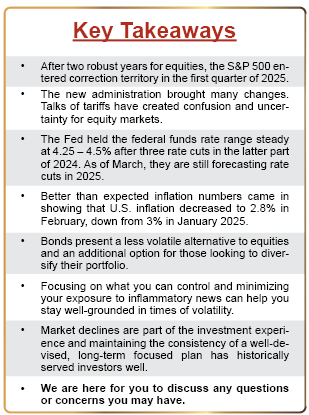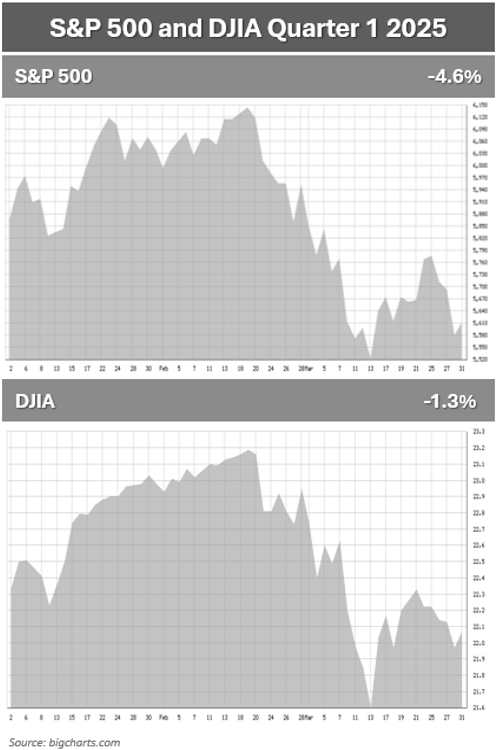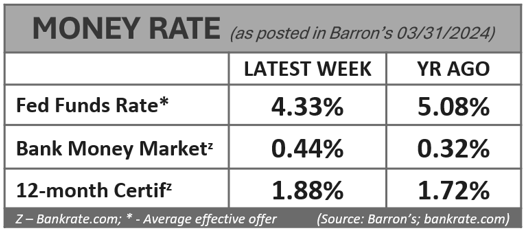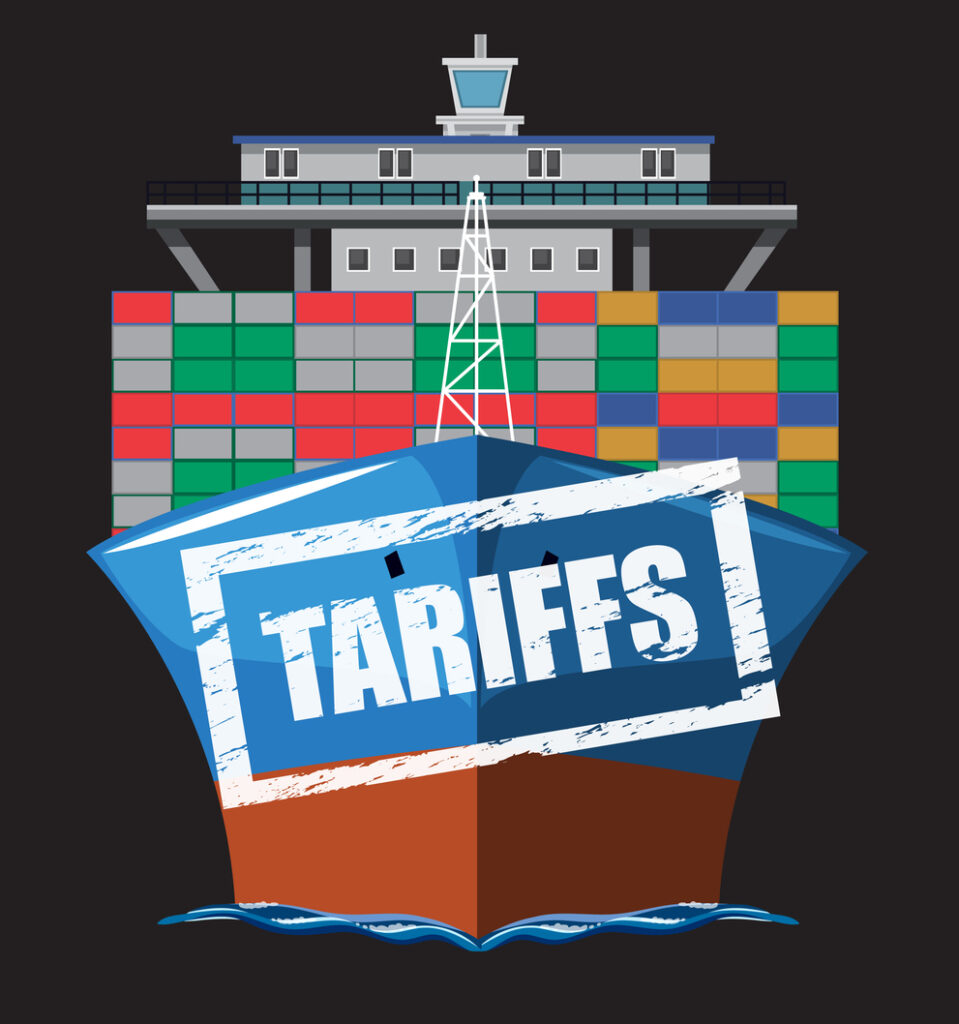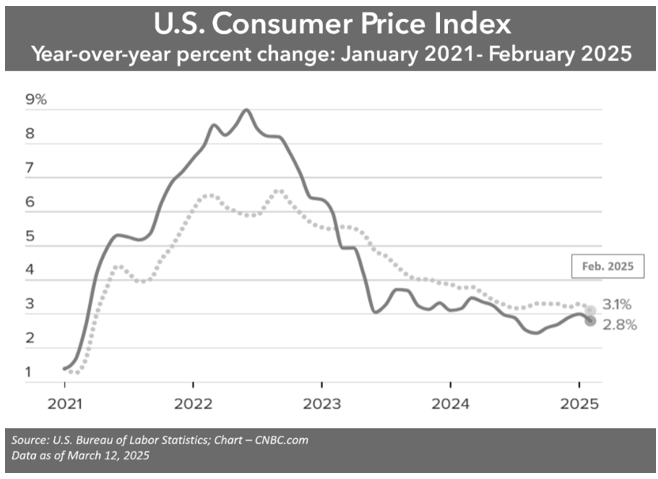Q1 2025 Newsletter
- 09
- Apr

Most analysts did not anticipate the volatility that investors would face in the first quarter of 2025. The equity markets started the quarter with strong momentum, buoyed by President Trump’s return to leadership of the world’s largest economy and financial markets. After achieving impressive annual returns of over 20% in both 2023 and 2024, the equity markets reached another all-time high in February. Experienced investors knew that a market retreat could happen at some point during the year, as it is historically common for a pullback or correction to follow such positive performance. In the latter half of the first quarter, uncertainty took center stage in the headlines, leading to a swift and widely reported market decline.
The new administration came in as it indicated it would, and President Trump’s first agenda was to make quick and sweeping change. The transitional time between new administrations typically brings some uncertainty and thus volatility, so it has been hard to predict the reaction to the aggressive agenda of this administration. Optimistic investor sentiment quickly dampened as campaign promises began to come to fruition. Some investors have become wary, and concerns over global trade wars and the tariffs have added to uncertainty.
A correction is defined as a decline of more than 10% from a recent closing high. On March 13, the S&P 500 fell 10% from its high set just three weeks prior due to easing inflationary pressure and positive earnings. The Dow Jones Industrial Average (DJIA) started its path toward correction territory but remained just above a 10% decline. Additional factors contributing to these declines included government employee layoffs, the possibility of a government shutdown, trade war probabilities and concerns about an uptick in inflation (Investopedia.com; 3/13/25).
The S&P 500 and DJIA entered the first quarter with positive momentum, after having both reached all-time highs in December 2024. The “Magnificent Seven” composed of Apple, Microsoft, Nvidia, Alphabet, Amazon, Meta and Tesla were the driving forces behind the U.S. stock market’s strength in the past two years. As a group, they accounted for more than 50% of the S&P 500’s return in both 2023 and 2024. That leadership continued through early February, however after a rough March, as a group, these tech stocks experienced their worst month and quarter on record. By March’s end, the S&P 500 registered its most difficult quarter since the second quarter of 2022. The S&P 500 closed the first quarter of 2025 down 4.6% and the DJIA closed the quarter down 1.3% (CNBC.com; 3/31/2025, First Trust 1/8/2025).
After experiencing three interest rate cuts in the latter half of 2024, the Federal Open Market Committee (FOMC) decided to maintain steady interest rates during the first quarter of 2025. Current Federal Funds interest rates are in the range of 4.25% to 4.50%.
In February, the unemployment rate was 4.1%, a slight increase from January’s 4.0%. Government employee layoffs began during the quarter, and federal government employment declined by 10,000 in February though government payrolls overall rose by 11,000. (cnbc.com; 3/7/25).
As financial professionals, we are committed to keeping our clients aware of any changes that could directly affect their situation. Our goal is to consistently review our clients’ investments and confirm they align with their time horizon, risk tolerance and goals.
Tariffs
Tariffs have become a nightly news agenda item and widely discussed topic and there are sizable concerns about their potential impact on the U.S. economy. The Trump administration is actively implementing several tariffs to protect domestic industries and boost sales of American-made products by taxing imports from countries like China, Canada, and Mexico. This includes a 25% tariff on all foreign-made cars, which is set to take effect in the second quarter. The White House has suggested that their tariffs will grow the American economy, help reduce our deficit and create jobs, but as of the quarter’s end has not issued complete guidance or specifics including how long they will be in place. For now, it remains uncertain how much these tariffs will affect the economy and inflation moving forward. Change always brings uncertainty, which remains a primary theme as the new administration’s overhaul is bringing growing and transitional pains in many areas of the U.S. government. We remain committed to keeping a watchful eye on these tariffs and their effects on our client’s investment portfolios.
Tariff Basics
A tariff is a tax on goods that are imported or exported between countries. Tariffs are a type of trade barrier that can raise prices and reduce the availability of goods and services.
How do tariffs work?
- Companies that import foreign goods pay the tariff to the government.
- Tariffs can be a percentage of the value of the imported product.
- Tariffs can also be a flat tax charged on each imported good.
Why are tariffs used?
- Tariffs are used to protect domestic industries and jobs.
- Tariffs can also be used to punish or discourage actions that a country disapproves of.
What are the effects of tariffs?
- Tariffs can increase the cost of production and the cost to the consumer.
- Tariffs can create tensions between countries and lead to trade wars.
- Tariffs can negatively affect the stock prices of companies that rely on imported goods.
Inflation & Interest Rates
Key Points
- Interest rates remained unchanged at 4.25 – 4.50% during the first quarter of 2025.
- The Fed is still forecasting rate cuts in 2025.
- U.S. inflation decreased in February to 2.80%.
In the Federal Reserve Press Release on March 19, 2025, the committee stated, “Economic activity has continued to expand at a solid pace. The unemployment rate has stabilized at a low level in recent months, and labor market conditions remain solid. Inflation remains somewhat elevated (Federal Reserve Press Release; 3/19/25).
In the first quarter of 2025, the Federal Open Market Committee (FOMC) decided to maintain interest rates in the range of 4.25% to 4.50%. This news positively influenced investor sentiment, leading to a brief rise in stock prices following the announcement. The Federal Reserve indicated that rate cuts are still possible this year, depending on whether inflation continues to decrease, and the job market remains robust.
During the March FOMC meeting, the committee noted that it anticipates the economy will slow down more than previously expected this year. At the March Press Conference, Federal Reserve Chair Jerome Powell stated, “some near-term measures of inflation expectations have recently moved up.” He continued, “We see this in both market- and survey-based measures, and survey respondents, both consumers and businesses, are mentioning tariffs as a driving factor. Beyond the next year or so, however, most measures of longer-term expectations remain consistent with our 2% inflation goal”(forbes.com; 3/22/25).
Good news emerged with lower-than-expected inflation numbers reported, showing that U.S. inflation decreased to 2.80% in February, down from 3% in January 2025. Nonetheless, inflation pressures remain a concern in the coming months as we see how tariffs affect the economy and spending (cnbc.com; 3/12/25).
The current economic climate presents significant uncertainty, and the FOMC is acutely aware of this, much like investors, who find themselves in a “wait and see” situation. Chair Powell expressed during the March press conference, “We’re going to have to see how things actually work out.” In February, the Consumer Price Index (CPI) for both core and all-items increased 0.2%. On a year-by-year basis, inflation was 2.8% and core inflation was 3.1%. The core CPI, which excludes food and energy prices, is often viewed by economists as a better gauge of future inflation. The increase in shelter costs in February accounted for nearly 50% of the overall CPI rise (cnbc.com; 3/12/25).
The FOMC is vigilant in monitoring key economic indicators, including labor market conditions, inflation pressures and expectations, as well as financial and international developments. With two FOMC meetings scheduled for the second quarter and four more planned for the second half of the year, the Fed remains committed to the possibility of interest rate cuts contingent upon inflation trends and economic conditions.
Interest and inflation rate movements are integral for investors’ financial planning, and we will continue to monitor these key economic indicators closely.
The Bond Market & Treasury Yields
Key Points
- The outlook for bonds in 2025 remains unclear. Interest rates, inflation trends, and clarity on tariffs, are all contributing to higher yields, however they remain sensitive to ongoing uncertainties.
- Current bond yields could present an appealing option for investors seeking more stability against market volatility.
Multiple factors are keeping U.S. Treasury yields higher, including economic uncertainty, a reluctant inflation rate, and unchanged interest rates. During the quarter, yields still experienced slight ups and downs. A rally was seen earlier in the quarter but was quickly undone as investors rode the fence of uncertainty due to tariffs and trade decisions that were still up in the air in the first quarter.
U.S. Treasury long-term yields rose to their highest levels in over a month on March 27. On March 31, the benchmark 10-year yields reached 4.23% and 30-year yields hit 4.59%. The shorter-term 2-year and 5-year yields were 3.89% and 3.96% respectively (U.S. Department of Treasury).
Bonds have an inverse relationship with interest rates—when one goes up, the other usually goes down. Bonds have historically been less risky in times of market uncertainty. If interest rates continue to fall, bonds should appreciate. This first quarter, however, interest rates were stagnant. Should inflation gain more momentum as feared, interest rates could remain in stagnation mode or even rise.
Diversification is an important strategy for a well-balanced portfolio and bonds can be a good defense play against market volatility. Bonds can offer stability and a steady interest income during times of market decline. We consider using them for clients based on each client’s unique situation. Please remember that while diversification in your portfolio can help you pursue your goals, it does not ensure a profit or guarantee against loss.
Investor’s Outlook
Key Points:
- More changes are likely to come, and volatility is likely to remain during this transitionary period.
- Focusing on what you can control is important. Proactive planning with a well-diversified portfolio that takes into consideration your risk tolerance and time horizon is advised.
- Investing is a long-term activity, and short-term fluctuations should not sidetrack you from your long-term goals.
- Collaborating with a qualified financial professional can help you understand market conditions and if and how they may affect your overall strategy.
Heading into 2025, investor sentiment was primarily optimistic, with a sprinkle of anticipation and caution. This sentiment changed quickly as the new cabinet was ushered in and a deluge of changes began coming to realization. The major disruption came when tariffs were discussed and confusion heightened.
More changes are still being discussed in other sectors of the government, including tax policy especially with the 2025 sunsetting of the Tax Cuts and Jobs Act provisions.
While no one can predict the future, strategists have been adjusting their year-end forecast. As you can see from the image, as the S&P 500 went into correction land in March, strategists from major banks slightly lowered their initial year-end targets. “We’ve revised our year-end S&P 500 target to 6,400, down from 6,600, reflecting the anticipated impact of tariffs on earnings growth. Despite this adjustment, we still foresee meaningful upside driven by positive US growth and robust AI demand,” UBS stated. “While we do expect ongoing uncertainty and volatility in the near term, our base case is that tariffs will not derail the economy. We expect the US economy to grow close to its 2% trend this year,” UBS added (seekingalpha.com; 3/31/2025).
Increased talk of a recession is being revived in the news. Analysts like Lori Calvasina of RBC Capital Markets, however, currently do not feel a recession is on the horizon. “Some economic forecasters around the Street have started to dial down their 2025 GDP forecasts, but are not calling for a recession,” Calvasina wrote to clients mid-March. “Historically, the dialing down of economic growth on its own presents a significant headwind for the stock market to overcome”(finance.yahoo.com; 3/17/25).
The bottom line is that uncertainty is dominating the headlines and investors will continue to seek clarity about many things in the coming months. Change usually comes with some volatility. How investors and savers navigate this volatility and uncertainty is vital for the direction of their financial goals. One of the most important things to remember is that investing is a long-term activity.
We urge you to remember what is in your control, and what is not. Some things you cannot control are tariffs and trade wars; adjustments to monetary policies; the inflation rate; interest rate changes; and how equities will respond to these and other issues. What you can control is how you react. Three major things you can control are:
- Your behavior
- Your risk tolerance or appetite; and
- Your time horizon.
If you have a firm grasp of each of these, you should be able to maintain discipline and remain calm when volatility and market fluctuations arise.
The first thing you should keep in mind is not to panic. In times of market volatility, investors tend to become unnerved and anxious. Most often, this is not the best mindset to make rational decisions.
Risk tolerance or appetite is the degree to which you are able or willing to withstand fluctuations in the stock market and your portfolio in return for growth potential. Knowing what your risk appetite is and having risk awareness should be a part of your financial strategy. If this changes, then you need to call us. Your investment time horizon is another vital component that you can control. Knowing how much time you have to reach your goals will help you determine other key elements like your risk tolerance. While no one can determine what will happen in equity markets during either the short- or long-term, if your horizon is longer, you may have more choices or a willingness to take on more risk. For example, an investor who can commit to a 10-year time horizon can consider different selections as compared to someone who needs to use that money in six months.
So, what should investors do?
Remember, the past two years have been exceptional for the U.S. stock market. Seasoned investors know this cannot always be the case, and that at some point a market correction would be inevitable. Corrections are unpleasant, but they are a part of the investing experience. As a reminder, the term “correction” is used to describe downturns of 10% to 20%, because historically, the market drop often “corrects” and returns equity prices to their longer-term trend.
Regardless of whether equities are rising or falling, investors should always put their main focus on their own personal objectives. If you need to, revisit your financial plan to make sure you are still situated on the best path toward your goals. Understanding changes in your time horizon and risk tolerance should be a part of your review.
As a reminder, equities should be viewed primarily as long-term investments and investors should be prepared to hold equity positions for at least three to five years or more. Short-term volatility comes and goes and should not distract you from your long-term plans. A well-crafted plan incorporates the fact that equities do not move in a straight line and can withstand the inevitable fluctuations of the markets.
Inflation is relatively moderate compared to previous years, but it is still above the Fed’s target of 2%. While the Fed still forecasts the possibility of rate cuts in 2025, uncertainty is prevalent, and recent years have taught us to remain vigilant and prepared for unexpected circumstances.
Regardless of what happens moving forward, it’s still wise to “proceed with caution.” We also want to reiterate that in times of volatility, we know that the temptation to deviate from your long-term strategies can arise. Please remember that “cashing out when fear takes over,” could result in missing out on the gains from a market recovery. Market downturns can be temporary and potentially even open a window of opportunity for good entry points into equities.
We stand by our belief that investing is a long-term activity and that a well-planned, long-term strategy that considers market volatility, time horizon, and risk tolerance, is the best practice for savvy investors. Rebalancing and appropriate diversification are important for all our clients. We believe in proactive preparation, and our aim is to provide you with a solid financial strategy that is thoughtfully designed for all market environments.
As always, you should stay informed about the news but minimize your exposure to avoid getting caught up in speculative claims, unfounded predictions and fearmongering.
2025 is definitely a year of change for the U.S. As stewards of your wealth, we will continue to monitor areas we feel are important to your financial situation and understand that the current changes are bringing uncertainty and increased market volatility. We are here for you should you feel apprehensive about your portfolio and financial plans.
Please keep us aware of any changes to your personal situations such as divorce, health issues, selling of property, or any changes to your risk tolerance or time horizon. Additionally, we always recommend discussing any changes, concerns, or ideas you may have with us before making any financial decisions. Keep in mind that there are often other factors to consider when altering anything in your financial plan, such as tax implications. The more knowledge we have about your unique financial situation the better equipped we will be to best advise you.
Our goal is to exceed our your expectations. We take pride in offering a high-level service that includes consistent and meaningful communication throughout the year. Our team is here to help you with every step of your journey toward your financial goals.
As a valued client, we want you to know that we are here for you. Please feel free to reach out to us with any questions or concerns you may have. We appreciate the trust and confidence you have in our firm.
We want to help others like you!
Many of our best relationships have come through introductions from our clients. We would be honored if you would:
- Add a name to our mailing list
- Invite a guest to a webinar or retirement class
- Encourage someone to schedule a complimentary financial consultation
Please call us at (714) 597-6510 or email info@fanwmg.com and we’d be happy to explore how we can help them with their financial goals!
Upcoming Events
- Saturday Retirement Classes (Mission Viejo): 4/12 & 4/19 from 8:30am to 1pm
- Investments Webinar | Wed, Apr 24 at 6pm
- Property Inheritance Webinar | Wed, Apr 30 at 6pm
- Saturday Retirement Classes (FAN): 5/3 & 5/10 from 8:30am to 1pm
- Social Security & Medicare Webinar | Wed, May 7 at 6pm
- FAN Corporate Trustee Services Webinar | Wed, May 14 at 6pm
- FAN Plan Basic Training Webinar | Wed, May 21 at 6pm
Financial Advisors Network, Inc. is a registered investment advisory firm. The views stated in this letter are not necessarily the opinion of Financial Advisors Network, Inc., and should not be construed, directly or indirectly, as an offer to buy or sell any securities mentioned herein. Investors should be aware that there are risks inherent in all investments, such as fluctuations in investment principal. With any investment vehicle, past performance is not a guarantee of future results. Material discussed herewith is meant for general illustration and/or informational purposes only, please note that individual situations can vary. Therefore, the information should be relied upon when coordinated with individual professional advice. This material contains forward-looking statements and projections. There are no guarantees that these results will be achieved. All indices referenced are unmanaged and cannot be invested into directly. Unmanaged index returns do not reflect fees, expenses, or sales charges. Index performance is not indicative of the performance of any investment. The S&P 500 is an unmanaged index of 500 widely held stocks that is general considered representative of the U.S. Stock market. The modern design of the S&P 500 stock index was first launched in 1957. Performance prior to 1957 incorporates the performance of the predecessor index, the S&P 90. Dow Jones Industrial Average (DJIA), commonly known as “The Dow” is an index representing 30 stocks of companies maintained and reviewed by the editors of the Wall Street Journal. Past performance is no guarantee of future results. CDs are FDIC Insured and offer a fixed rate of return if held to maturity. Due to volatility within the markets mentioned, opinions are subject to change without notice. Information is based on sources believed to be reliable; however, their accuracy or completeness cannot be guaranteed.
There is an inverse relationship between interest rate movements and bond prices. Generally, when interest rates rise, bond prices fall and when interest rates fall, bond prices generally rise. There is no guarantee that a diversified portfolio will enhance overall returns out outperform a non-diversified portfolio. Diversification does not protect against market risk. Sources: cnbc.com; treasury.gov; bigcharts.com; Department of Treasury; firsttrust.com; Federal Reserve Press Release; finance.yahoo.com; seekingalpha.com; Investopedia.com; forbes.com; U.S. Department of Treasury. Contents provided by the Academy of Preferred Financial Advisors, 2025
- Macaela Fahey
- Uncategorized
- Comments Off on Q1 2025 Newsletter




